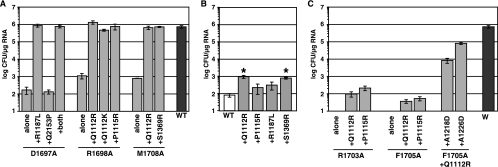FIG. 3.
Second-site mutations in NS3 suppress defects caused by mutations in the NS4A acidic region. Data are presented as described in the legend to Fig. 2. (A) The indicated single, double, and triple mutations were tested in the context of Con1b/SG-Bsd(I). The replication phenotypes of D1697A, R1698A, M1708, and the wild type (WT) are reproduced from Fig. 1A for comparison. (B) The effects of each NS3 mutation were tested in the context of wild-type Con1b/SG-Bsd, which lacks cell culture-adaptive mutations. Asterisks indicate statistically significant differences (P ≤ 0.01 [Student's t test]) from the wild type. (C) The indicated single, double, and triple mutations were tested in the context of Con1b/SG-Bsd(I). The replication phenotypes of R1703A, F1705A, and the wild type are reproduced from Fig. 1A for comparison.

